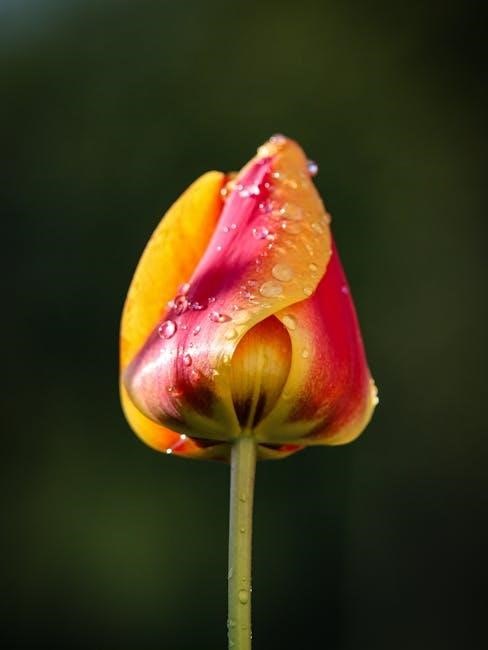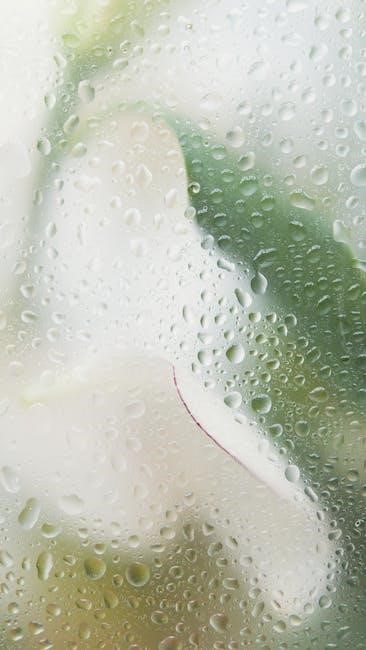Dry bulb, wet bulb, and relative humidity are essential parameters for understanding air properties. Dry bulb temperature measures air heat, while wet bulb temperature reflects cooling effects. Relative humidity indicates moisture levels, crucial for climate and HVAC applications.
Definition of Dry Bulb Temperature
Dry bulb temperature measures the ambient air temperature using a thermometer shielded from radiation. It reflects the actual heat of the air, unaffected by moisture. This parameter is crucial for understanding air properties and is commonly used in psychrometric charts to determine relative humidity and wet bulb temperatures. It serves as the horizontal axis in these charts, providing a baseline for analyzing air conditions in HVAC systems and environmental studies. Accurate measurement ensures reliable data for various applications.
Definition of Wet Bulb Temperature
Wet bulb temperature is measured using a thermometer wrapped in a wet cloth, indicating the lowest temperature achievable through evaporation. It reflects the cooling effect of air on water, influenced by humidity and airflow. This temperature is always lower than the dry bulb temperature unless the air is fully saturated. Wet bulb temperature is vital in psychrometric charts for assessing cooling potential and human comfort levels in various environments, particularly in HVAC and meteorological applications.
Definition of Relative Humidity
Relative humidity (RH) is the percentage of water vapor in the air compared to the maximum amount the air can hold at a given temperature. It is calculated using dry bulb and wet bulb temperatures; RH influences comfort, weather patterns, and industrial processes. Higher RH reduces evaporation, affecting cooling systems and human heat stress. Psychrometric charts provide RH values by intersecting dry and wet bulb temperatures, essential for HVAC, agriculture, and meteorology applications.
Understanding the Psychrometric Chart
A psychrometric chart graphs air properties, plotting dry bulb temperature on the x-axis and relative humidity on the y-axis, with lines for wet bulb temperatures and dew points.
What is a Psychrometric Chart?
A psychrometric chart is a graphical tool used to visualize the thermodynamic properties of air. It plots dry bulb temperature on the x-axis and relative humidity on the y-axis, incorporating wet bulb temperatures, dew points, and other air properties. This chart is essential for analyzing air conditions in various fields like HVAC, meteorology, and agriculture, allowing users to determine humidity levels, cooling effects, and heat transfer processes efficiently.
Components of the Psychrometric Chart
The psychrometric chart consists of a dry bulb temperature axis (horizontal) and a relative humidity axis (vertical). Wet bulb temperature lines are diagonally drawn, while dew point temperatures are plotted along the upper curve. Specific humidity and enthalpy values are also included. These components allow users to analyze air properties, such as humidity, cooling effects, and energy transfer, making it a comprehensive tool for HVAC, meteorology, and industrial applications.
How to Read the Psychrometric Chart
To read the psychrometric chart, locate the dry bulb temperature on the horizontal axis. Draw a vertical line at this point. Next, find the wet bulb temperature on the diagonal lines and draw a horizontal line. The intersection of these lines gives the relative humidity. Additional properties like dew point and specific humidity can also be determined by referencing other chart features, enabling comprehensive analysis of air conditions for various applications.
Dry Bulb Temperature and Its Significance
Dry bulb temperature measures air’s thermal heat, crucial for human comfort and HVAC systems. It influences cooling loads and industrial processes, as shown in psychrometric charts.
Measurement of Dry Bulb Temperature
Dry bulb temperature is measured using a thermometer exposed to air, unaffected by moisture. Thermometers are typically shielded from radiation to ensure accurate readings. Digital and mercury-in-glass types are common. Proper placement and shielding are essential for precise measurements, especially in HVAC and meteorological applications. Regular calibration ensures reliability, making it a fundamental tool in psychrometric chart usage for assessing environmental conditions accurately.
Importance of Dry Bulb Temperature in HVAC
Dry bulb temperature is crucial in HVAC systems for designing and controlling heating, cooling, and ventilation. It determines system performance, airflow, and energy efficiency. Accurate measurements ensure optimal indoor air quality and thermal comfort. Psychrometric charts rely on dry bulb data to calculate relative humidity and wet bulb temperatures, essential for system sizing and operation. This ensures efficient moisture control and prevents issues like condensation or overheating in buildings, making it a key factor in maintaining occupant comfort and system reliability.
Wet Bulb Temperature and Its Applications
Wet bulb temperature is crucial for assessing air humidity and cooling effects. It is widely used in meteorology, agriculture, and HVAC systems to evaluate environmental conditions and optimize cooling processes.
Measurement of Wet Bulb Temperature
Wet bulb temperature is measured using a thermometer wrapped in a wet cloth, exposed to air flow. As water evaporates, it cools the bulb, indicating the air’s cooling capacity. This measurement is vital for understanding evaporative cooling effects and is commonly used inmeteorology, HVAC, and industrial processes to assess humidity and heat stress conditions. Accurate measurement requires proper instrumentation and environmental conditions.
Role of Wet Bulb Temperature in Cooling Systems
Wet bulb temperature is crucial in cooling systems as it determines the evaporative cooling potential. It reflects the lowest temperature achievable through evaporation, influencing system design and performance. By understanding wet bulb temperature, engineers optimize cooling processes, ensuring efficient heat removal. This parameter is essential for maintaining desired environmental conditions in HVAC systems and industrial applications, preventing overheating and ensuring energy efficiency.
Relative Humidity and Its Relationship with Temperature
Relative humidity measures air’s moisture content relative to its maximum capacity at a specific temperature. It is influenced by dry bulb and wet bulb temperatures, crucial for understanding air properties and environmental conditions.
Understanding the Relationship Between Temperature and Humidity
Temperature and humidity are closely linked, with dry bulb temperature measuring air heat and wet bulb temperature reflecting evaporative cooling effects. Relative humidity, the ratio of water vapor present to the maximum possible, is influenced by these temperatures. Higher dry bulb temperatures can hold more moisture, lowering relative humidity. Conversely, lower temperatures or higher wet bulb temperatures increase relative humidity. This relationship is vital for accurately interpreting psychrometric charts and understanding environmental conditions, particularly in HVAC and meteorological applications.
Calculating Relative Humidity Using Dry and Wet Bulb Temperatures
Relative humidity (RH) can be determined using dry and wet bulb temperatures. Subtract the wet bulb temperature from the dry bulb temperature to find the difference. Using a psychrometric chart, locate the dry bulb temperature on the x-axis and move up to the wet bulb temperature line. The intersection point indicates the RH percentage. For example, if the dry bulb is 18°C and the wet bulb is 12°C, the RH is approximately 49%. This method is essential for accurately interpreting environmental conditions in HVAC and meteorological applications.

How to Use the Dry Bulb Wet Bulb Temperature Relative Humidity Chart
Locate the dry bulb temperature on the x-axis and the wet bulb temperature on the chart. Follow the intersecting lines to determine the relative humidity percentage accurately.
Step-by-Step Guide to Using the Chart
Identify the dry bulb temperature on the x-axis and the wet bulb temperature on the y-axis. 2. Locate their intersection point on the chart. 3. Follow the curved lines to determine the relative humidity percentage. 4. Use the color-coded zones or additional scales for dew point or enthalpy if needed. 5. Double-check readings for accuracy, especially for critical applications like HVAC or meteorology. This method ensures precise determination of air properties for various environmental conditions.
Interpreting the Chart for Various Environmental Conditions
The chart is versatile, aiding in understanding air properties across diverse environments. For meteorology, it helps predict weather patterns by linking dry bulb, wet bulb, and relative humidity. In agriculture, farmers use it to optimize crop storage and irrigation. HVAC systems rely on it to balance indoor climates. By analyzing the chart, one can determine comfort levels, heat stress risks, and moisture-related issues. It also guides adjustments for precise environmental control, ensuring accurate readings for specific conditions.
Applications of the Chart in Different Fields
The chart is widely used in meteorology, agriculture, and HVAC systems. It aids in weather forecasting, crop management, and indoor climate control, ensuring efficient environmental regulation.
Use in Meteorology and Weather Forecasting
In meteorology, the chart is vital for analyzing atmospheric conditions. By plotting dry bulb and wet bulb temperatures, forecasters determine relative humidity, dew point, and heat index. This data helps predict weather patterns, including precipitation and fog formation. Additionally, it aids in calculating the wet bulb globe temperature (WBGT), crucial for assessing heat stress in outdoor environments. The chart’s accuracy ensures reliable forecasting, benefiting both public safety and agricultural planning.
Use in Agriculture and Crop Management
The chart is invaluable in agriculture for optimizing crop conditions. By monitoring dry bulb and wet bulb temperatures, farmers determine relative humidity, essential for seed germination and plant growth. It helps manage irrigation systems, preventing overwatering and reducing fungal diseases. Additionally, the chart aids in calculating dew point, crucial for frost prediction, which protects crops. This data-driven approach ensures optimal harvests and reduces crop losses, making it a key tool for modern agricultural practices.
Use in Industrial and HVAC Systems
In industrial and HVAC systems, the chart is critical for maintaining optimal air quality and equipment performance. Dry bulb and wet bulb temperatures help determine cooling load requirements, ensuring efficient system operation. Relative humidity control prevents moisture-related issues, such as mold growth and equipment corrosion. By analyzing these parameters, industries can optimize heating, ventilation, and air conditioning systems, reducing energy costs and enhancing indoor air quality for occupant comfort and productivity.

Differences Between Dry Bulb and Wet Bulb Temperatures
Dry bulb temperature measures air heat, while wet bulb temperature reflects cooling effects due to moisture evaporation. The difference indicates humidity levels, guiding climate and HVAC applications.
Implications of the Difference in Various Environments
The difference between dry and wet bulb temperatures has significant environmental implications. In industrial settings, it affects cooling system efficiency and humidity control. In agriculture, it influences crop drying and storage conditions. For human comfort, a larger difference reduces heat stress, while a smaller difference increases discomfort. Meteorologically, it helps predict weather patterns and heat indices. Understanding these differences is crucial for optimizing systems and ensuring safety across diverse applications.
Impact on Human Comfort and Heat Stress
Humidity and temperature differences significantly affect human comfort. High relative humidity reduces the body’s cooling ability, increasing heat stress. Wet bulb temperatures above 28°C pose health risks, especially during physical activity. Dry bulb temperatures, while indicating air heat, don’t account for moisture. Together, they determine the heat index, crucial for assessing workplace safety and public health. Accurate measurements help prevent heat-related illnesses and enhance environmental comfort in various settings.

Dew Point Temperature and Its Relationship with Dry and Wet Bulb Temperatures
Dew point temperature is the air’s saturation point, derived from dry and wet bulb temperatures, crucial for determining humidity levels and moisture content in environments.
Understanding Dew Point and Its Measurement
Dew point is the temperature at which air becomes saturated with moisture, causing condensation. Measured using psychrometric charts or calculators, it relies on dry and wet bulb temperatures. Devices like thermometers and hygrometers are used to determine dew point, essential for predicting fog, frost, and humidity-related phenomena. Accurate measurement helps in various applications, including meteorology, HVAC, and agriculture, ensuring efficient climate control and moisture management. This data is vital for environmental assessments and system optimizations.
Calculating Dew Point from Psychrometric Charts
Dew point is calculated by locating the intersection of dry bulb and wet bulb temperatures on a psychrometric chart. By aligning the dry bulb temperature on the x-axis and wet bulb temperature on the y-axis, the point where they meet indicates the dew point. This method provides a precise measurement of the temperature at which air becomes saturated with moisture. Digital tools and charts simplify this process, ensuring accurate determination for various environmental and industrial applications.

Heat Index and Wet Bulb Globe Temperature (WBGT)
Heat Index combines air temperature and humidity to measure perceived heat. WBGT considers temperature, humidity, wind, and radiation, assessing heat stress risks. Both are crucial for meteorology and industrial safety.
Understanding Heat Index and Its Calculation
The heat index, often called the “felt air temperature,” combines dry bulb temperature and relative humidity to reflect how hot it feels. It accounts for the body’s inability to cool itself through sweating when humidity is high. The calculation uses a formula involving dry bulb temperature and relative humidity, typically derived from psychrometric charts. This index is crucial for weather forecasting and assessing heat-related health risks, especially in extreme conditions. Accurate measurements help prevent heat stress and ensure public safety.
Wet Bulb Globe Temperature and Its Significance
Wet Bulb Globe Temperature (WBGT) measures environmental heat stress, combining dry bulb temperature, wet bulb temperature, and solar radiation. It’s crucial for assessing heat risks in outdoor and industrial settings. WBGT uses a formula weighting these factors to reflect perceived heat. Unlike heat index, it includes solar radiation, making it more comprehensive. WBGT is vital for occupational safety, sports, and military training, ensuring activities are adjusted to prevent heat-related illnesses. Accurate WBGT measurements enhance safety protocols and environmental comfort assessments.
Troubleshooting Common Issues with the Chart
Address inaccuracies in temperature readings by recalibrating sensors. Resolve humidity discrepancies by cross-checking with psychrometric tables. Ensure accurate measurements for reliable environmental assessments and data interpretation.
Addressing Inaccuracies in Temperature Readings
Inaccuracies in temperature readings can arise from faulty sensors or improper calibration. Regularly inspect and recalibrate devices to ensure precision. Environmental factors like drafts or direct sunlight may skew results. Use psychrometric tables or charts to cross-verify measurements. Ensure thermometers are correctly placed to avoid exposure to interfering elements. Implementing these steps enhances data reliability and accuracy in determining dry bulb, wet bulb, and relative humidity values for precise environmental assessments and system operations.
Resolving Discrepancies in Humidity Measurements
Discrepancies in humidity readings often stem from sensor malfunctions or incorrect chart interpretations. Ensure instruments are calibrated and free from contamination. Cross-reference measurements using psychrometric charts and tables. Check for consistency between dry bulb, wet bulb, and relative humidity values. Environmental conditions, such as air pressure variations, can also affect accuracy. Regular maintenance and adherence to measurement protocols help minimize errors and ensure reliable humidity data for accurate environmental analysis and system performance.
The dry bulb, wet bulb, and relative humidity chart remains a vital tool in understanding air properties. Future advancements may integrate digital solutions for enhanced accuracy and accessibility.
Dry bulb, wet bulb, and relative humidity are critical for understanding air properties. Dry bulb temperature measures air heat, while wet bulb reflects evaporative cooling. Relative humidity indicates moisture content, essential for climate and HVAC applications. These parameters help analyze heat stress, cooling systems, and environmental comfort. The psychrometric chart integrates these values, enabling precise calculations for various industrial and meteorological applications.
Emerging Trends in Psychrometric Chart Usage
The use of psychrometric charts is evolving with advancements in digital tools and automation. Modern software integrates real-time data from sensors, enabling precise calculations. Mobile apps now offer portable access to psychrometric calculations, enhancing fieldwork efficiency. Additionally, machine learning algorithms improve predictive capabilities for HVAC and environmental monitoring. These innovations make psychrometric analysis more accessible and accurate, supporting industries like agriculture, meteorology, and industrial systems. The integration of IoT devices further streamlines data collection, ensuring optimal performance in various applications.




About the author